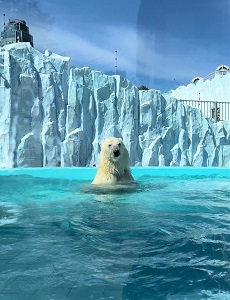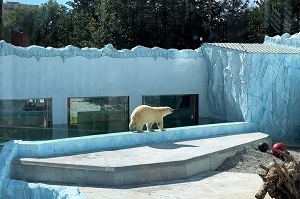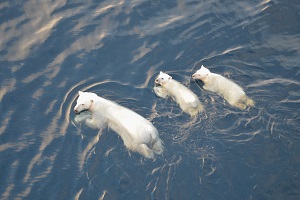Please activate JavaScript in your browser to use all interface options.
Rosneft Supports Renovation of Polar Bear Enclosure in Yekaterinburg Zoo
19 August 2022
Rosneft Oil Company has supported the reconstruction of an enclosure for polar bears in Yekaterinburg Zoo as part of its care programme for polar bears in Russia’s zoos. Much beloved Khatanga and Aina polar bears have been moved into the new enclosure, which has over twice as much space and over five times the pool volume.
The renovation included overhauling the dens, internal premises for veterinary care and temporary housing, and completely renewing the infrastructure and communications. The enclosure now also has a dry pool filled with river pebbles. Polar bears enjoy walking across such areas that imitate natural ground and spend a long time exploring the stony mounds.
 The enclosure at Yekaterinburg Zoo is positioned four metres below the level of the main area. From now on, visitors can observe the animals both from above and through the glazing of the underwater part of the pool.
The enclosure at Yekaterinburg Zoo is positioned four metres below the level of the main area. From now on, visitors can observe the animals both from above and through the glazing of the underwater part of the pool.
Rosneft considers the preservation and protection of polar bears as one of its priorities in the field of environmental protection. Since 2013, all polar bears in all Russian zoos are in the custody of the Company to be provided with adequate nutrition, veterinary service and improved living conditions. In addition, Rosneft helped to develop, for the first time in Russia, special toys for polar bears. Several types of toys are made of particularly durable plastic and sent to all member zoos yearly.
 Rosneft is also implementing a comprehensive programme to study polar bears in the wild. The results of numerous expeditions help to significantly expand and update data on these animals, which are a symbol of the Arctic and the only large predator in the area, as well as to develop measures to protect their populations.
Rosneft is also implementing a comprehensive programme to study polar bears in the wild. The results of numerous expeditions help to significantly expand and update data on these animals, which are a symbol of the Arctic and the only large predator in the area, as well as to develop measures to protect their populations.
Between 2018 and 2022, Rosneft has conducted a number of unique studies and assessments of polar bear populations, jointly with Russia’s leading polar bear specialists from the Severtsov Institute of Ecology and Evolution (Russian Academy of Sciences), the Marine Mammals Scientific Expedition Centre, the Wildlife Society, and the Central Siberian State Reserve.
the Marine Mammals Scientific Expedition Centre, the Wildlife Society, and the Central Siberian State Reserve.
The material obtained makes an invaluable contribution to the overall data set, which helps to assess polar bear population dynamics, as well as the extent to which climate change and anthropogenic pressures are affecting rare mammal species inhabiting the Arctic region. The research results are not only of high scientific value, but also have an applied nature, making it possible to plan and carry out economic activities of subsoil users in the Arctic with a high level of environmental responsibility.
 Rosneft is also implementing a programme to rescue and rehabilitate young polar bears left in the wild without maternal care. In 2019, in the north of the Krasnoyarsk Region, the Company participated in the rescue of two bears — a year-old Marfa in Norilsk and Ursula from Dikson Island. Both bears are currently kept in the Roev Ruchey Park of Flora and Fauna in Krasnoyarsk, where a new spacious enclosure for them is about to be completed.
Rosneft is also implementing a programme to rescue and rehabilitate young polar bears left in the wild without maternal care. In 2019, in the north of the Krasnoyarsk Region, the Company participated in the rescue of two bears — a year-old Marfa in Norilsk and Ursula from Dikson Island. Both bears are currently kept in the Roev Ruchey Park of Flora and Fauna in Krasnoyarsk, where a new spacious enclosure for them is about to be completed.
Note for Editors:
The polar bear is one of the key species-indicators of the condition of Arctic ecosystems, standing at the top of the food chain.
Scientists estimate the number of polar bears to be between 22,000 and 31,000. A large part of the species’ range is located in the Russian part of the Arctic. The special conservation status of the polar bear has force throughout the entire range—they are included in the Red Book of the Russian Federation and in the Red List of the International Union for Conservation of Nature and Natural Resources.
Rosneft
Information Division
August 19, 2022

-315xx70.png)

